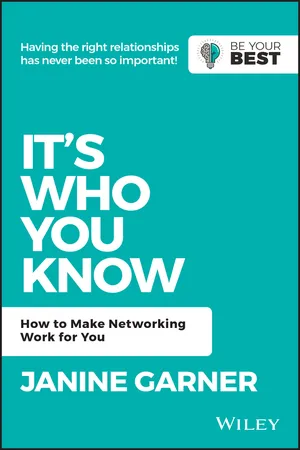The 2012 movie Disconnect features three different groups of characters, their search for connection and their dependence on technology. A young married couple who recently lost a baby have their identities stolen and exposed online. Two teenagers use Facebook to cyber-bully a lonely and unpopular classmate whose hardworking lawyer father is so hardwired to his phone that he can't find the time to communicate with his family. An ambitious TV reporter uncovers a story about an 18-year-old webcam porn performer that could make her career — then she falls in love with him.
These disparate stories become increasingly entangled and connected as the film progresses. By the end (spoiler alert!), they all come to realise that what is most important in life is the love they share with those closest to them, from whom they have become estranged and disconnected.
Connecting. Networking. Sounds simple, maybe too simple. These are not new concepts. Rather, connecting and networking have been the cornerstones of good business since business began.
As explored in the movie Disconnect, the internet has opened up a whole new world of content, connections and networking possibilities. The explosion of digital and social media has fundamentally changed the way we function, communicate and do business both online and offline.
Yet the technology that was supposed to connect us and bring us closer together actually seems to be having the reverse effect.
SOMETHING ABOUT HOW WE ARE NETWORKING
RIGHT NOW JUST ISN'T WORKING.
When I first started networking back in the eighties, 22 years old and fresh out of university, the hardest part was knowing where to go for help and support. In those early days of my career, networking was mostly about hanging out with your crew from work at a nearby bar. If you were lucky enough to be invited to a company or industry function, you'd pull on your power suit of confidence and off you'd go armed with a wallet full of business cards and a 30-second elevator pitch.
The goal was to swap cards and chat with as many people as possible. This was relatively easy, albeit a little nerve-racking, though the cheap wine helped. The follow-up involved a phone call, or maybe a handwritten ‘nice to meet you' note sent by snail mail, with the business card you'd just collected filed in your plump Rolodex or a plastic sleeve in a Filofax.
These days we are bombarded by multiple networking groups, industry-specific events and meet-ups through friends and colleagues or via LinkedIn, Facebook, Twitter and assorted other channels. Then there's speed networking (designed along the lines of speed dating), an event format in which you have a brief set time span to strike up a ‘connection' before you have to move on to the next person.
But are we really connecting here?
#Connecting or #disconnecting?
American psychiatrist Edward Hallowell writes,
Never in human history have our brains had to work with so much information as they do today … We have a generation of people who are so busy processing the information received from all directions that they are losing the ability to think and feel.
The explosion of social media has turned the world of face-to-face interactions upside down, opening up previously unimagined opportunities and ways of connecting with our friends, peers, existing and future clients, and complete strangers worldwide — all at the touch of a button. We are more connected than ever before through our smartphone, the internet, instant messaging and social media.
According to statsita.com, ‘The power of social networking is such that the number of worldwide users is expected to reach some 2.95 billion by 2020, around a third of the Earth's entire population.' New social networking sites are popping up every minute. LinkedIn is growing at the rate of two new members per second.
WITH THE INCREASE IN ‘CONNECTION', HOWEVER, HAS COME A PARALLEL INCREASE IN ‘DISCONNECTION'.
In her book Alone Together, social psychologist Sherry Turkle argues that our relentless connection to the digital world is actually driving isolation. On the whole, she says, we are now ‘more lonely and distant from one another … This is not only changing the way we interact online, it's straining our personal relationships, as well.'
A 2013 study by Hanna Krasnova and a group of researchers from two German universities1 examined the impact of envy on Facebook. The study concluded that one in three people felt worse after visiting Facebook. ‘Lurkers' who spent time looking at everyone else's content, while not posting any of their own, felt especially dissatisfied. This behaviour led to feelings of loneliness, frustration and anger.
These feelings are encapsulated in the label FOMO, or Fear of Missing Out, which is defined in the Oxford Dictionary as ‘anxiety that an exciting or interesting event may currently be happening elsewhere, often aroused by posts seen on social media'.
Social media encourages one-way communication. Status updates and shout-outs, overloading and oversharing of personal information and hashtags — #kidspam, #foodenvy, #bestdayever, #grateful, #inspired — make us look ‘good' but feel ‘bad', and add very little of actual value to our lives.
In reality, our actual conversations tend to be brief, fleeting and superficial. A quick scan of any café, restaurant, bus, train or footpath will suggest we're more interested in what is happening on our screens than in the people next to us — even our children, who are now babysat with Peppa Pig on the iPad.
Sure, we're connected, but increasingly to the digital world rather than to the real world and each other. Networking, on the other hand, relies on two-way communication: the mutual exchange of information and value.
So if we're feeling stressed out with all this frivolous one-way online communication, how has this affected the way we view and do networking?
The ‘work' in network
So many of us avoid networking because we see it as exactly that ...
